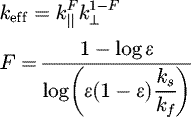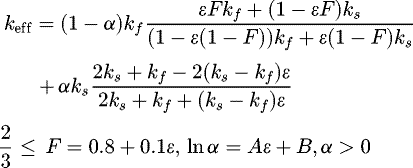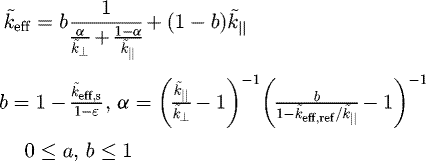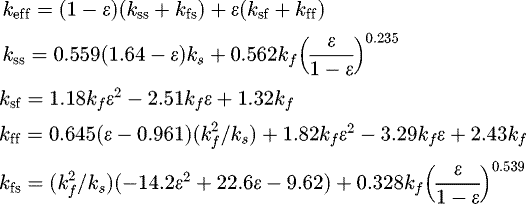Open Access
Table B3
Empirical correlations.
| Researcher | Correlation | Remark |
|---|---|---|
| Calmidi and Mahajan [33] |

|
Developed for metal foam with porosity ranges higher than 90% C1: depends on fluid material and Best fit was obtained for C2 = 0.763 |
| Ingersoll, from reference [99] |

|
Developed for moist soils. Modified version of the Series model |
| Dul'nev and Zarichnyak, from reference [58,100] Bhattacharya et al. [13] Dietrich et al. [101] |
|
Dul'nev and Zarichnyak: A = 3/2 Bhattacharya et al.: A = 0.35 In [103] the intrinsic solid phase conductivity is used |
| Ackermann et al. [102] |
|
Developed for Reticulated Porous Ceramic (RPC) |
| Ackermann et al. [102] |

|
Developed for Reticulated Porous Ceramic (RPC) |
| Chaudhary and Bhandari, from reference [58] |

|
0 ≤ F ≤ 1: fraction of solid in direction of the heat flow |
| Singh and Kasana [51] |

|
Developed for metal foams. C = 0.9683 (Air). C = 1.0647 (Water) after fitting data of [13] |
| Jagjiwanram and Singh [103] corrected |

|
θ: slab inclination with respect to the heat flow |
| Krisher [104] |

|
Packed bed of spheres. A highly anisotropic structure is assumed |
| Kumar et al. [105] |

|
Derived from Maxwell upper bound. Values of A and B were obtained from fitting for different materials such as rocks, polymers, and composites |
| Hadley [30] |

|
Developed for a consolidated mixture of two metal powders. No values of A and B for metal foams |
| Mendes et al. [106] Mendes et al. [107] Wulf et al. [53] |

|
|
| Mendes et al. [108] |

|
Open-cell foam-like structures. Where |
| Fourie and Du Plessis [61] |

|
Under thermal non-equilibrium condition. kss, kff: effective thermal conductivities. kfs, ksf coupled thermal conductivities. Properties of representive unit cell varies in range of: 0.8 < ε < 0.98 and 0.0001 < kf/ks < 0.1 |
| Coquard et al. [60] |

|
Developed for metal and ceramic foams. Correlations obtained after fitting of numerical results for variety of unit cells (cube, dodecahedron, tetrakaidecahedron), struts (triangular, square) and lumps (cubic, parallelepipedic). D: characteristic dimension of lumps. d: characteristic dimension of strut cross-section. |
| Woodside and Messmer, from reference [99] |
|
Unconsolidated sands. |
| Krupiczka, from reference [1] |

|
Developed for packed beds of spherical particles. |
| Hamilton and Crosser [59] |

|
Developed for heterogeneous two-component mixtures. |
| Lemlich, from reference [39] |
|
Derived for the electrical conductivity of polyhedral liquid foams. |
| Ashby [109] |
|
Developed for cellular solids (foams and lattices). |
| Bhattacharya et al. [13] |

|
The best fit for all the data was found for A = 0.35 |
| Sadeghi et al. [70] |
|
Developed for Al foams with porosity range from 0.9 to 1. |
Current usage metrics show cumulative count of Article Views (full-text article views including HTML views, PDF and ePub downloads, according to the available data) and Abstracts Views on Vision4Press platform.
Data correspond to usage on the plateform after 2015. The current usage metrics is available 48-96 hours after online publication and is updated daily on week days.
Initial download of the metrics may take a while.


